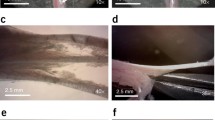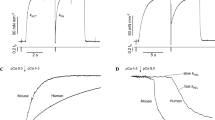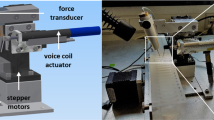Abstract
We studied the biomechanical properties of the sarcolemma and its links through costameres to the contractile apparatus in single mammalian myofibers of Extensor digitorum longus muscles isolated from wild (WT) and dystrophin-null (mdx) mice. Suction pressures (P) applied through a pipette to the sarcolemma generated a bleb, the height of which increased with increasing P. Larger increases in P broke the connections between the sarcolemma and myofibrils and eventually caused the sarcolemma to burst. We used the values of P at which these changes occurred to estimate the tensions and stiffness of the system and its individual elements. Tensions of the whole system and the sarcolemma, as well as the maximal tension sustained by the costameres, were all significantly lower (1.8–3.3 fold) in muscles of mdx mice compared to WT. Values of P at which separation and bursting occurred, as well as the stiffness of the whole system and of the isolated sarcolemma, were ~2-fold lower in mdx than in WT. Our results indicate that the absence of dystrophin reduces muscle stiffness, increases sarcolemmal deformability, and compromises the mechanical stability of costameres and their connections to nearby myofibrils.






Similar content being viewed by others
References
Allen DG, Lamb GD, Westerblad H (2008) Skeletal muscle fatigue: cellular mechanisms. Physiol Rev 88:287–332
Anastasi G, Cutroneo G, Santoro G, Arco A, Rizzo G, Bramanti P, Rinaldi C, Sidoti A, Amato A, Favaloro A (2008) Costameric proteins in human skeletal muscle during muscular inactivity. J Anat 213(3):284–295
Ayalon G, Davis J, Scotland P, Bennett V (2008) An ankyrin-based mechanism for functional organization of dystrophin and dystroglycan. Cell 135(7):1189–1200
Barton E (2006) Impact of Sarcoglycan complex on mechanical signal transduction in murine skeletal muscle. Am J Physiol Cell Physiol 290(2):C411–C419
Beedle A, Nienaber P, Campbell K (2007) Fukutin-related protein associates with the sarcolemmal dystrophin–glycoprotein complex. J Biol Chem 282(23):16713–16717
Bhosle R, Michele D, Campbell K, Li Z, Robson R (2006) Interactions of intermediate filament protein synemin with dystrophin and utrophin. Biochem Biophys Res Commun 346(3):768–777
Blaauw B, Mammucari C, Toniolo L, Agatea L, Abraham R, Sandri M, Reggiani C, Schaffino S (2008) Akt activation prevents the force drop induced by eccentric contractions in dystrophin-deficient skeletal muscle. Hum Mol Genet 17(23):3686–3696
Blaauw B, Agate L, Toniolo L, Canato M, Quarta M, Dyar K, Danieli-Betto D, Betto R, Schiaffino S, Reggiani C (2010) Eccentric contractions lead to myofibrillar dysfunction in muscular dystrophy. J Appl Physiol 108(1):105–111
Bloch R, Gonzalez-Serratos H (2003) Lateral force transmission across costameres in skeletal muscle. Exerc Sport Sci Rev 31(2):73–78
Bloch R, Capetanaki Y, O’Neill A, Reed P, Williams MW, Resneck W, Porter N, Ursitti J (2002) Costameres: repeating structures at the sarcolemma of skeletal muscle. Clin Orthop Relat Res 403S:S203–S210
Boal D (2006) Mechanics of the cell. Cambridge University Press, Cambridge
Bobet J, Mooney RF, Gordon T (1998) Force and stiffness of old dystrophic (mdx) mouse skeletal muscles. Muscle Nerve 21(4):536–539
Brenman J, Chao D, Xia H, Aldape K, Bredt D (1995) Nitric oxide synthase complexed with dystrophin and absent from skeletal muscles sarcolemma in Duchenne muscular dystrophy. Cell 82(5):743–752
Bull H (1964) An introduction to physical biochemistry. Davis Co, Philadelphia
Campbell K, Stull T (2003) Skeletal muscle basement membrane–sarcolemma–cytoskeleton interaction minireview series. J Biol Chem 278(15):12599–12600
Caputo C, Bolaños P (1994) Fluo-3 signals associated with potassium contractures in single amphibian muscle fibers. J Physiol 481:119–128
Claffin D, Brooks S (2008) Direct observation of failing fibers in muscles of dystrophic mice provides mechanistic insight into muscular dystrophy. Am J Physiol Cell Physiol 294:C651–C658
Dmytrenko G, Pumplin D, Bloch R (1993) Dystrophin in membrane skeletal network: localization and comparison to other proteins. J Neurosci 13(2):547–558
Dulhunty AF, Franzini-Armstrong C (1975) The relative contribution of the folds and caveolae to the surface membrane of frog skeletal muscle fibers at different sarcomere length. J Physiol 250:513–539
Dull RW (1941) Mathematics for engineers. McGraw-Hill Book Company, New York
Ehmer S, Herrmann H, Bittner R, Voit T (1997) Spatial distribution of beta-spectrin in normal and dystrophic human skeletal muscle. Acta Neuropathol 94(3):240–246
Ervasti J (2003) Costameres: the Achilles’ heel of herculean muscle. J Biol Chem 278(16):13591–13594
Ervasti J (2007) Dystrophin, its interactions with other proteins, and implications for muscular dystrophy. Biochem Biophys Acta 1772(2):108–117
Ervasti J, Campbell K (1991) Membrane organization of the dystrophin–glycoprotein complex. Cell 66(6):1121–1131
Ervasti J, Campbell K (1993) A role for the dystrophin–glycoprotein complex as a transmembrane linker between laminin and actin. J Cell Biol 122:809–823
Evans E, Hochmuth M (1976) Membrane viscoelasticity. Biophys J 16(1):1–11
Evans E, Yeung A (1989) Apparent viscosity and cortical tension of blood granulocytes determined by micropipette aspiration. Biophys J 56:151–160
Fonbrune P (1949) Technique de Micromanipulation. Massonn et Cie, Paris
Garcia-Pelagio K, Bloch R, Ortega A, Gonzalez-Serratos H (2006) Elastic properties of the sarcolemma–costamere complex of muscle cells in normal mice. AIP Conf Proc 854:51–53
Garcia-Pelagio K, Bloch R, Ortega A, Gonzalez-Serratos H (2008) Passive viscoelastic properties of costameres in EDL muscle in normal and dystrophin null mice. AIP Conf Proc 1032:268–271
Goldspink G, Fernandes K, Williams PE, Wells DJ (1994) Age-related changes in collagen gene expression in the muscles of mdx dystrophic and normal mice. Neuromuscul Disord 4(3):183–191
Gonzalez-Serratos H (1971) Inward spread of activation in vertebrate muscle fibres. J Physiol 212(3):777–799
Gordon AM, Huxley AF, Julian FJ (1966) The variation in isometric tension with sarcomere length in vertebrate muscle fibers. J Physiol 184:170–192
Hochmuth M (2000) Micropipette aspiration of living cells. J Biomech 33:15–22
Hoffman EP, Brown R, Kunkel L (1987) Dystrophin: the protein product of the Duchenne muscular dystrophy locus. Cell 51:919–928
Hutter OF, Burton FL, Bovell DL (1991) Mechanical properties of normal and mdx mouse sarcolemma: bearing on function of dystrophin. J Muscle Res Cell Motil 12:585–589
Lapidos K, Kakkar R, McNally M (2004) The dystrophin glycoprotein complex: signaling strength and integrity for the sarcolemma. Circ Res 94:1023–1031
Leckie FA, Dal Bello DJ (2009) Strength and stiffness of engineering systems. Springer, New York
Minetti C, Cordone G, Beltrame F, Bado M, Bonilla E (1998) Disorganization of dystrophin costameric lattice in Becker muscular dystrophy. Muscle Nerve 21(2):211–216
Mitchison JM (1953) The thickness of the sea urchin fertilization membrane. Exp Cell Res 5(2):536–538
Na S, Chowdhury F, Tay B, Ouyang M, Gregor M, Wang Y, Wiche G, Wang N (2009) Plectin contributes to mechanical properties of living cells. Am J Physiol Cell Physiol 296(4):C868–C877
Needham D, Hochmuth M (1992) A sensitive measure of surface stress in the resting neutrophil. Biophys J 61(6):1664–1670
Nelkon M (1979) Scholarship physics. Hienemann Educational Publishers, London
Nigro V, Piluso G, Belsito A, Politano L et al (1996) Identification of a novel sarcoglycan gene at 5q33 encoding a sarcolemmal 35 kDa glycoprotein. Hum Mol Genet 5(8):1179–1186
Nowak K, Davies K (2004) Duchenne muscular dystrophy and dystrophin: pathogenesis and opportunities for treatment. EMBO Rep 5:872–876
O’Neill A, Williams MW, Resneck W, Milner D, Capetanaki Y, Bloch RJ (2002) Sarcolemmal organization in skeletal muscle lacking desmin: evidence for cytokeratins associated with membrane skeleton at costameres. Mol Biol Cell 13:2347–2359
Oak SA, Zhou YW, Jarrett HW (2003) Skeletal muscle signaling pathway through the dystrophin glycoprotein complex and Rac1. J Biol Chem 278(41):39287–39295
Ohlendieck K, Ervasti J, Snook J, Campbell K (1991) Dystrophin–glycoprotein complex is highly enriched in isolated skeletal muscle sarcolemma. J Cell Biol 112:135–148
Ozawa E (1998) From dystrophinopathy to sarcoglycanopathy: evolution of a concept of muscular dystrophy. Muscle Nerve 21:421–438
Pasternak C, Elson E (1985) Lymphocyte mechanical response triggered by cross-linking surface receptors. J Cell Biol 100:860–872
Pasternak C, Wong S, Elson E (1995) Mechanical function of dystrophin in muscle cells. J Cell Biol 128(3):355–361
Pellicer J, García-Morales V, Hernández MJ (2000) On the demonstration of the Young–Laplace equation in introductory physics courses. Phys Educ 35(2):126–129
Petersen N, McConnaughey W, Elson E (1982) Dependence of locally measured cellular deformability on position on the cell, temperature, and cytochalasin B. Proc Natl Acad Sci USA 79:5327–5331
Petrof B, Shrager J, Stedman H, Kelly A, Sweeney L (1993) Dystrophin protect the sarcolemma from stresses developed during muscle contraction. Proc Natl Acad Sci USA 90:3710–3714
Porter G, Dmytrenko G, Winkelmann J, Bloch R (1992) Dystrophin colocalizes with beta-spectrin in distinct subsarcolemmal domains in mammalian skeletal muscle. J Cell Biol 117(5):997–1005
Quach NL, Rando TA (2006) Focal adhesion kinase is essential for costamerogenesis in cultured skeletal muscle cells. Dev Biol 293:38–52
Rand RP (1964) Mechanical properties of the red cell membrane. Biophys J 4:303–316
Rapoport S (1972) Mechanical properties of the sarcolemma and myoplasm in frog muscle as a function of sarcomere length. J Gen Physiol 59:559–585
Reed P, Bloch RJ (2005) Postnatal changes in sarcolemmal organization in mdx mouse. Neuromuscul Disord 15(8):552–561
Rybakova I, Patel J, Ervasti J (2000) The dystrophin complex forms a mechanically strong link between the sarcolemma and costameric actin. J Cell Biol 150(5):1209–1214
Shah S, Davis J, Weisleder N, Kostavassili I, McCulloch A, Raltson E, Capetanaki Y, Lieber R (2004) Structural and functional roles of desmin in mouse skeletal muscle during passive deformation. Biophys J 86:2993–3008
Stone MR, O’Neill A, Lovering R, Strong J, Resneck WG, Reed PW, Toivola D, Ursitti J, Omary BM, Bloch RJ (2007) Absence of keratin 19 in mice causes skeletal myopathy with mitochondrial and sarcolemmal reorganization. J Cell Sci 120(22):3999–4008
Straub V, Bittner R, Leger J, Voit T (1991) Direct visualization of the dystrophin network on skeletal muscle fiber membrane. J Cell Biol 119(5):1183–1191
Street SE (1983) Lateral transmission of tension in frog myofibers: a myofibrillar network and transverse cytoskeletal connections are possible transmitters. J Cell Physiol 114:346–364
Taylor R (2005) Classical mechanics. University Science Books, Sausalito
Thoumine O, Cardoso O, Meister JJ (1999) Changes in the mechanical properties of fibroblasts during spreading: a micromanipulation study. Eur Biophys J 28(3):222–234
Trans-Son-Tay R, Needham D, Yeung A, Hochmuth M (1991) Time-dependent recovery of passive neutrophils after large deformation. Biophys J 60(4):856–866
Tsai M, Frank R, Waugh R (1993) Passive mechanical behavior of human neutrophils: power law fluid. Biophys J 65:2078–2088
Ursitti JA, Lee PC, Resneck WG, McNally MM, Bowman AL, O’Neill A, Stone MR, Bloch RJ (2004) Cloning and characterization of cytokeratins 8 and 19 in adult rat striated muscle. Interaction with the dystrophin glycoprotein complex. J Biol Chem 279(40):41830–41838
Waugh E, Evans E (1979) Thermoelasticity of red blood cell membrane. Biophys J 26:115–132
Wieneke S, Stehle R, Li Z, Jockusch H (2000) Generation of tension by skinned fibers and intact skeletal muscles from desmin-deficient mice. Biochem Biophys Res Commun 278:419–425
Williams MW, Bloch RJ (1999a) Extensive but coordinate reorganization of the membrane skeleton in myofibers of dystrophic (mdx) mice. J Cell Biol 144:1259–1270
Williams MW, Bloch RJ (1999b) Differential distribution of dystrophin and beta-spectrin at the sarcolemma of fast twitch skeletal muscle fibers. J Muscle Res Cell Motil 20:383–393
Winder S (1997) The membrane-cytoskeleton interface: the role of dystrophin and utrophin. J Muscle Res Cell Motil 18:617–629
Wojcikiewicz E, Zhang X, Moy V (2004) Force and compliance measurements on living cells using Atomic Force Microscopy (AFM). Biol Proced Online 6:1–9
Wolff AV, Niday AK, Voelker KA, Call JA, Evans NP, Granata KP, Grange RW (2006) Passive mechanical properties of maturing extensor digitorum longus are not affected by lack of dystrophin. Muscle Nerve 34(3):304–312
Zhang Q, Wang X, Wei X, Chen W (2007) Characterization of viscoelastic properties of normal and osteoarthritic chondrocytes in experimental rabbit model. Osteoarthr Cartil 16(7):837–840
Zubrzycka-Gaarn E, Bulman D, Karpati G et al (1988) The Duchenne muscular dystrophy gene product is localized in sarcolemma of human skeletal muscle. Nature 333(6172):466–469
Acknowledgments
This research was partially supported by grants to R. J. Bloch from the National Institute of Heath (5R01AR055928) and the Muscular Dystrophy Association. K. P. García-Pelagio was supported during the Ph. D. program (Doctorado en Ciencias Biomédicas, Universidad Nacional Autónoma de México) by a scholarship from Consejo Nacional de Ciencia y Tecnología.
Author information
Authors and Affiliations
Corresponding author
Rights and permissions
About this article
Cite this article
García-Pelagio, K.P., Bloch, R.J., Ortega, A. et al. Biomechanics of the sarcolemma and costameres in single skeletal muscle fibers from normal and dystrophin-null mice. J Muscle Res Cell Motil 31, 323–336 (2011). https://doi.org/10.1007/s10974-011-9238-9
Received:
Accepted:
Published:
Issue Date:
DOI: https://doi.org/10.1007/s10974-011-9238-9




